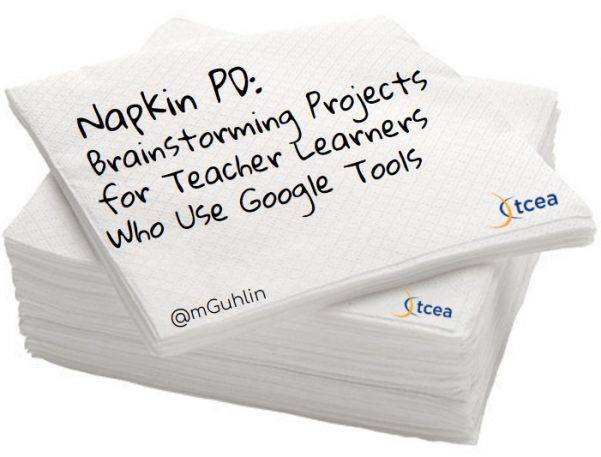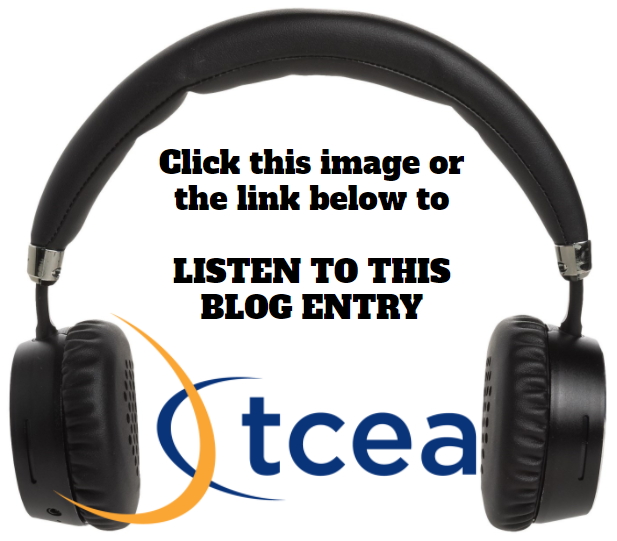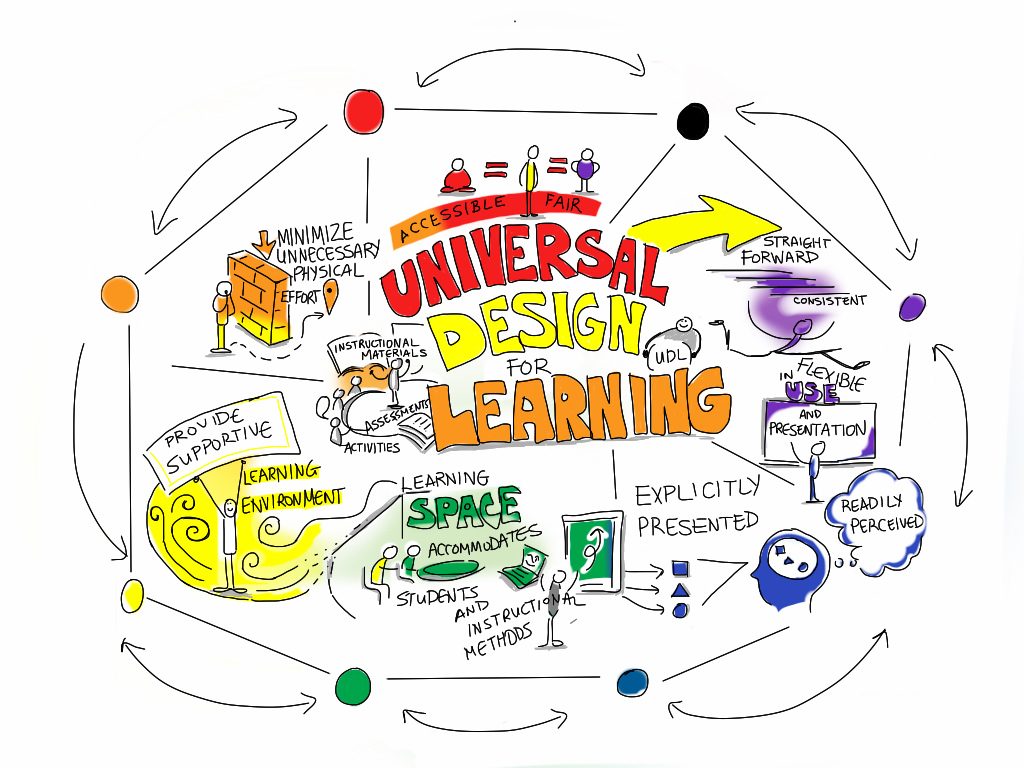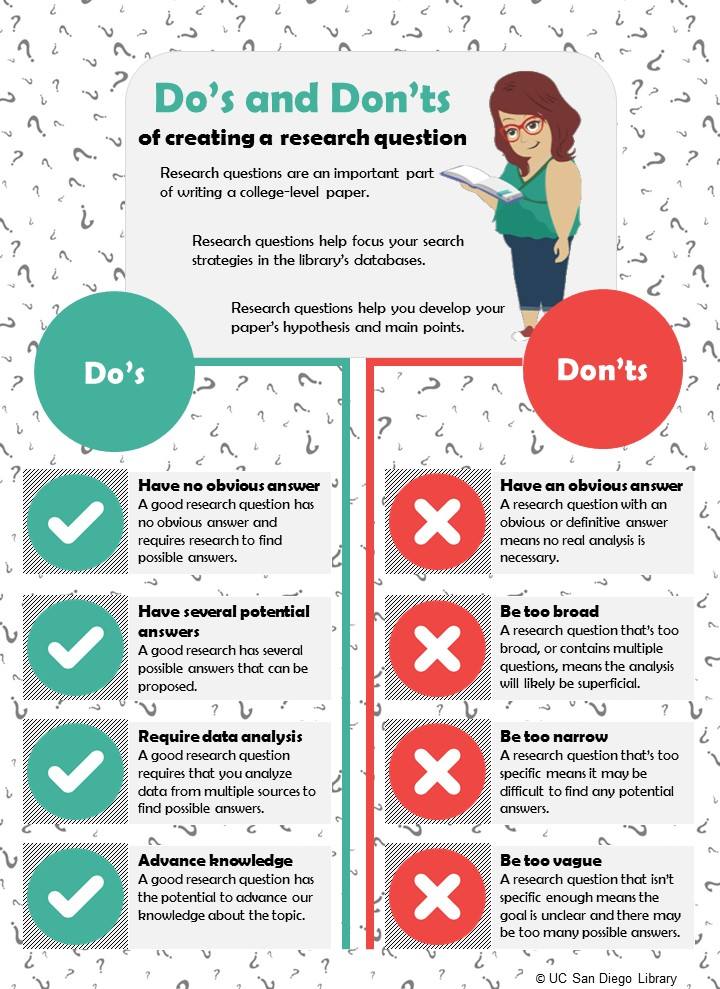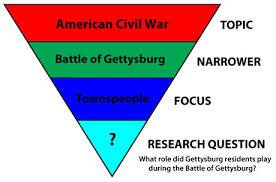Teachers often struggle during professional development sessions, wondering how to make connections between how-to at the workshop and classroom learning. Diana Benner, Peggy Reimers, and I did some napkin PD planning and came up with a solution. Here’s a chance to get hands-on Google experience with six different project stations that offer the opportunity to explore lesser-known Google tools. These tools enhance critical thinking, communication, creativity, and collaboration.
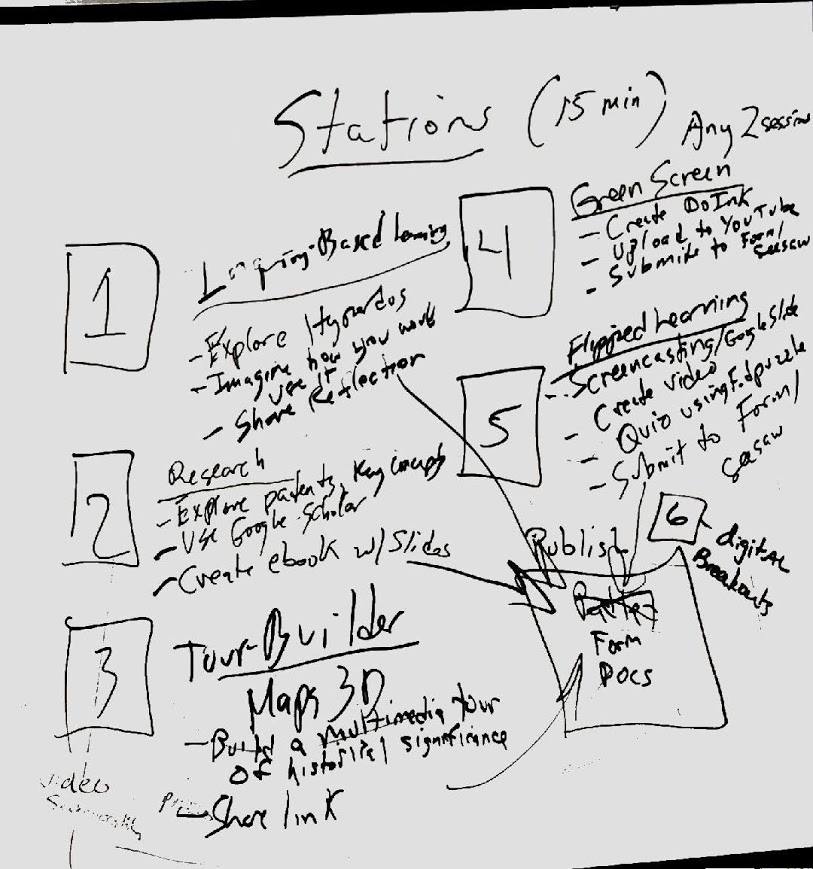
Developing PD on a napkin with Diana Benner, Peggy Reimers, and Miguel Guhlin. Let’s explore these ideas in more detail.
Essential Elements
Before we jump into the project stations, let’s review a few components common to each. Each project station includes three components:
- Explore
- Adapt/Create
- Share
In the Explore portion, participants develop background knowledge in the key concept shared. In the Adapt/Create, they make connections between their own experiences as learners. Two ways to accomplish this include adapting an existing work in light of new information. The second way is to create a new product. After they create or adapt, they share that online with a global audience. An additional component is listing what Google tools will be used.
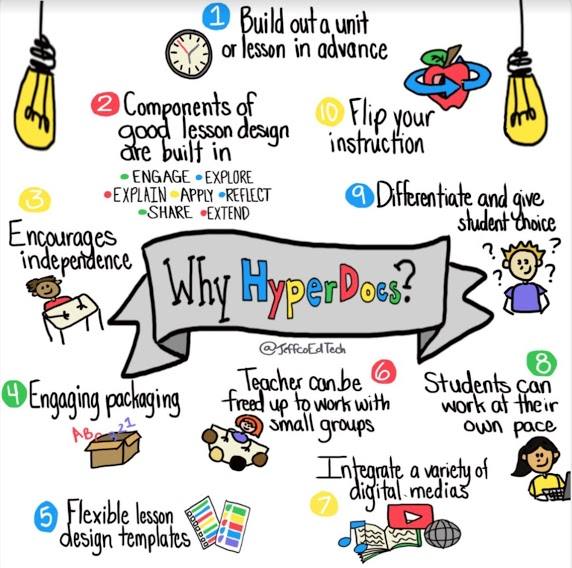
Source: @JeffCoEdTech
Project Station #1: Inquiry-Based Learning Developers
In this station, participants will explore inquiry-based learning (IBL). Why continue to introduce IBL in professional learning? IBL creates engagement in both teachers and learners. Research has shown it has several benefits. It can:
- Boost students’ learning in inter-disciplinary studies
- Motivate students to learn, developing flexible, real-life, problem-solving strategies
- Deepen critical thinking skills
- Use of knowledge in new areas (Source)
Learning to ask the right questions and then finding answers that work remain critical to the work of educators and their students. To that end, it’s important to scaffold the use of IBL in the context of modern tools. Not unlike Dr. Bernie Dodge’s and Tom March’s webquest activity, new approaches adapt IBL for modern technology.
- Explore: In this station, participants are given twenty minutes.
- Adapt/Create: Participants, having explored hyperdoc exemplars, rely on a template to develop their own hyperdoc.
- Share: Participants share their hyperdoc creation or modification with others via a sharing space, such as Google Forms tied into a Google Sheet or link their hyperdoc in an existing Google Doc created for that purpose.
- Tools: Google Docs, Google Slides
Project Station #2: Research Explorers
One of the first uses of the internet for teachers involves encouraging students to use it for research. It’s important to clarify expectations for research-based activities. While research should be embedded in the context of an inquiry-based learning lesson, some additional expectations can be set. Students can be expected to:
- Craft a research question
- Locate and gather appropriate sources
- Consider and assess the quality of the sources
- Seek patterns in the data
- Develop a position about the research
Given that the internet is a deep ocean of information, it’s important to assist students to engage in content curation using frameworks like the Big 6, Super 3, and Universal Design for Learning (UDL). While there are many online research tools that could be introduced, one of note is Google Scholar.
“I usually start with Google Scholar or Google just to figure out what the topic is. Once I have a better idea, I’ll go deeper,” says Leslie Harris O’Hanlon. “For example, if it’s a history paper, I’ll use the online library catalog, or sometimes there are e-books online through the university” (Source).
- Explore: Participants experience the power of Google Scholar as a tool to find journals, save document sources in a personal space, and obtain citations. First, participants go through the process of developing a research question using the infographic from UC San Diego Library as a guide. Then they complete the steps.
- Adapt/Create: Participants begin with a general topic, then narrow the topic down with How and Why questions, not unlike what is shown in the image below:
- Share: Once participants have identified a topic using Google Scholar to identify research and information, they can create a Google Slides PDF ebook or Google Docs.
- Tools: Google Scholar, Google Docs ePub export or Google Slides PDF ebook
Project Station #3: Engaging Experiments
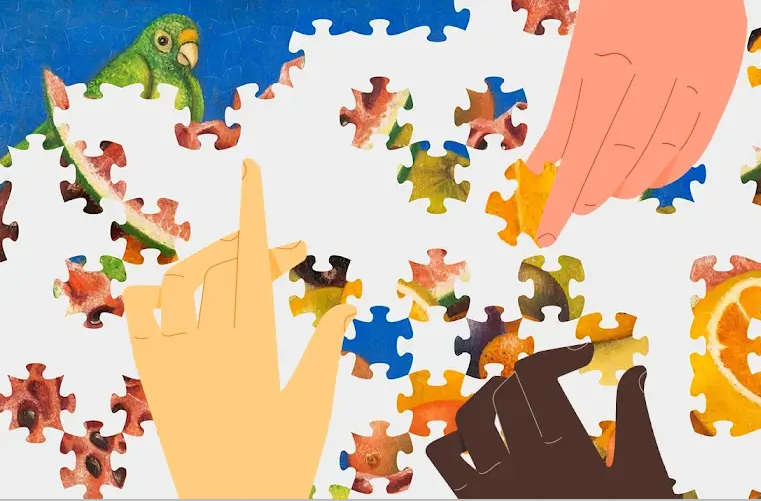 Mix up learning for your students. Create engaging and relevant learning experiences for students with Google’s Art and Culture. Better yet, try out one of the Arts & Culture experiments. You can find gaming experiments that enable students to interact with images, solve puzzles, and more. This map-based approach enables students to organize their research according to location and impact, which is appropriate for various topics. Students combine research, life stories, images, and video to make a compelling case for their research thesis.
Mix up learning for your students. Create engaging and relevant learning experiences for students with Google’s Art and Culture. Better yet, try out one of the Arts & Culture experiments. You can find gaming experiments that enable students to interact with images, solve puzzles, and more. This map-based approach enables students to organize their research according to location and impact, which is appropriate for various topics. Students combine research, life stories, images, and video to make a compelling case for their research thesis.
- Explore: Encourage participants to explore existing Arts & Culture experiments and then reflect on how current content in their curriculum goals could be aligned.
- Adapt/Create: Participants use puzzle maker to create a game puzzle, or cultural crossword puzzle.
- Share: Once participants have finished it, make it available via a Google Form or common space or backchannel (e.g. Padlet).
- Tools: Google Arts & Culture puzzle maker
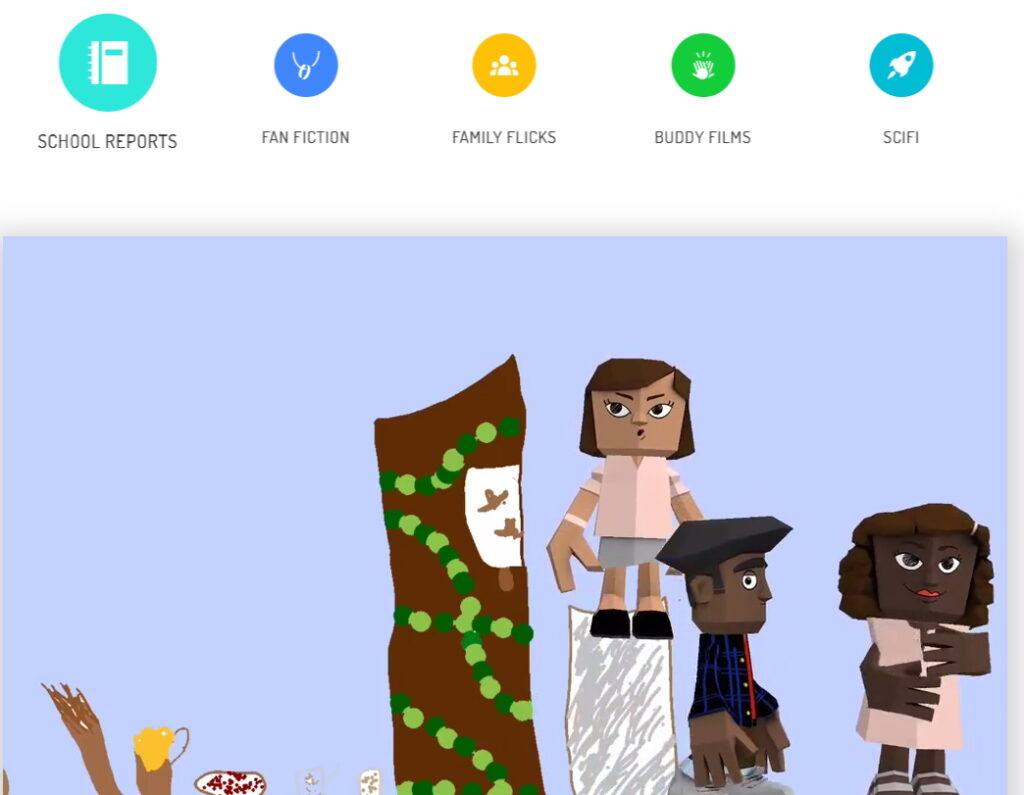
Source: Toontastic School Reports
Project Station #4: Toontastic Reporters
Whether you have students synthesizing information from a variety of sources and then reporting it in front of a green screen (read tips about setting up your own inexpensive green screen, as well as see examples) or creating reports with Toontastic, students can learn quite a bit. Putting students in the role of journalists has a powerful impact on their own ability to curate and construct knowledge. Consider the following benefits:
- Students develop the critical thinking skills needed to be smarter, frequent, transliterate consumers (and creators) of information
- Students learn to tell between fact and opinion
- Learners explore how to become better-informed citizens and voters (Source: The News Literacy Project)
One approach to achieve this involves presenting a problem and then inviting students to create a report that presents facts.
- Explore: Toontastic projects from various grade levels. Reflect on how students could craft their own news report.
- Adapt/Create: Map out a report or story (Source), then create the report using Toontastic in a Chrome browser. You can also choose to use an app like Do Ink for iPad for green screen magic. You may want to review journalism basics in the context of the Three Little Pigs.
- Share: Google Site
- Tools: Toontastic app or Chromebook
Wait, There’s More
Ready to get going with these project stations? Consider adding two more, if time allows. Two more final project stations include casting teachers in the roles of Flipped Learning Creators and Digital Breakout Artists.
In the former, flipped learning is explored. Participants learn to create screencasts, embed assessments with EdPuzzle, or engage in post-reflection activities with Google Forms. In the Digital Breakout Artists project station, participants learn how to create engaging activities that involve clue finding and problem solving.
Turn Napkin PD into a Reality
Want to schedule TCEA professional learning for your school district that focuses on inquiry-based learning? Fill out a TCEA logistics form, as well as attend our face-to-face conferences and the annual TCEA Convention. We can help you turn your napkin professional development plans into a reality.

